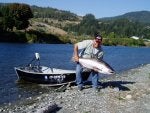To osseous's point; whether a small stream trout, salmon, bonefish or tarpon, we are fishing. The cast, drift, eat and fight are partly scalable, partly relative to the characteristic of the species we're pursuing. Appropriately, one can fish a reel with a spring and pawl check overrun, with or without a palming rim up to a mega-drag Able or Tibor...it remains a matter of applying flexible fatiguing stress on the fish to bring it to hand. Rod angle, line control along with reel/hand pressure contribute to the gamefish tiring. Athletic tarpon expert, Andy Mill mentioned above keeps his rod angle low and avoids excessive use of his arms and back, using leg strength to subdue triple digit migratory tarpon. Somewhat similarly, Billy Pate applied the "down and dirty" to these powerful fish. I'll apply that to a trout with room to run, using water tension on the line and opposing low rod flex to steer the fish away from a snag or out of bigger currents.
For me, after all these years now with trout reels with smooth, fine drags, non-existent when I was young or to the old timers before us, there is no debate about drag or no drag. I have established beyond reasonable doubt that given the same 9'/#5 on the Henry's Fork, the same big fat rainbow, with the variable being my well worn CFO IV with rim or a Hatch 4+ (or equivalents), I will bring to net that trout some distinct % faster having the drag available, all my abilities and enjoyments being equal, and release it in good health sooner, free of lactose acid build up or pelican predation by the judicious employment of drag. I'm a manual dexterity guy and fished classic Hardy reels for a long time until the mid 80's when reels started becoming more sophisticated. I still fish a CFO on a small stream but our wild fish's well being is of paramount importance and since I go abound trying to capture and release them, every one that does not get so worn out as to be eaten by a bird or shark, I'm happier about.

